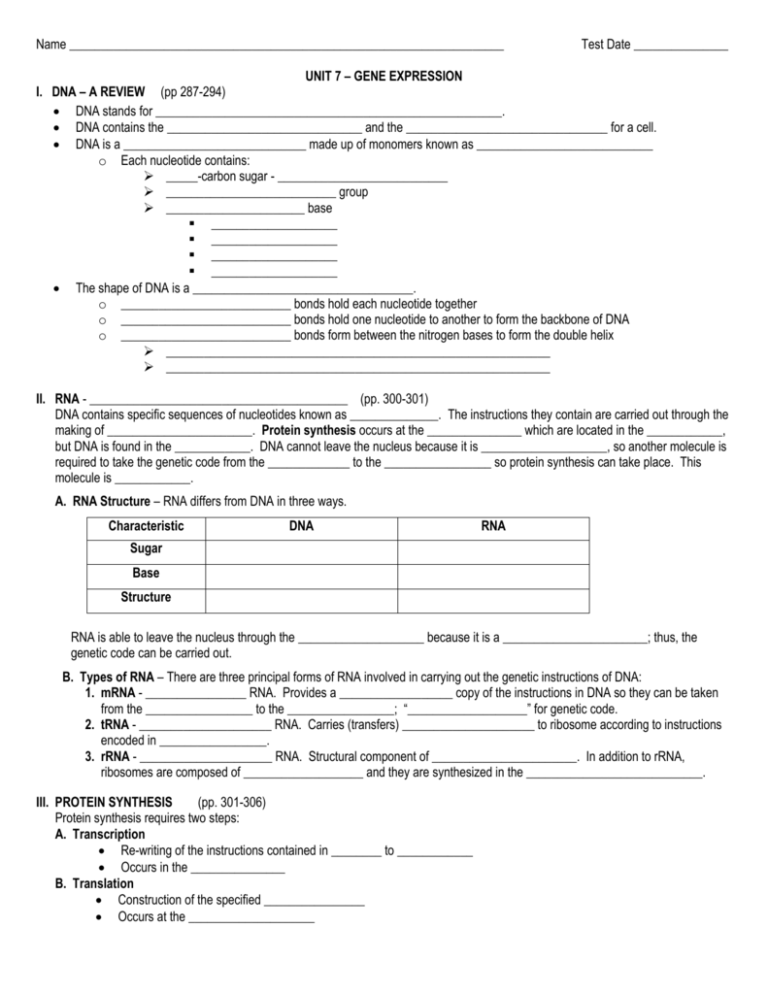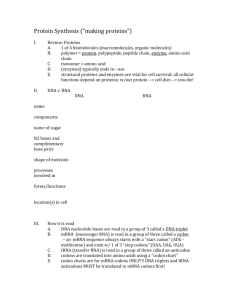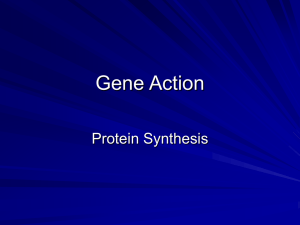unit 7
advertisement

Name _____________________________________________________________________ Test Date _______________ UNIT 7 – GENE EXPRESSION I. DNA – A REVIEW (pp 287-294) DNA stands for _______________________________________________________. DNA contains the _______________________________ and the ________________________________ for a cell. DNA is a _____________________________ made up of monomers known as ____________________________ o Each nucleotide contains: _____-carbon sugar - ___________________________ ___________________________ group ______________________ base ____________________ ____________________ ____________________ ____________________ The shape of DNA is a ___________________________________. o ___________________________ bonds hold each nucleotide together o ___________________________ bonds hold one nucleotide to another to form the backbone of DNA o ___________________________ bonds form between the nitrogen bases to form the double helix _____________________________________________________________ _____________________________________________________________ II. RNA - _________________________________________ (pp. 300-301) DNA contains specific sequences of nucleotides known as ______________. The instructions they contain are carried out through the making of _______________________. Protein synthesis occurs at the _______________ which are located in the ____________, but DNA is found in the ____________. DNA cannot leave the nucleus because it is ____________________, so another molecule is required to take the genetic code from the _____________ to the _________________ so protein synthesis can take place. This molecule is ____________. A. RNA Structure – RNA differs from DNA in three ways. Characteristic DNA RNA Sugar Base Structure RNA is able to leave the nucleus through the ____________________ because it is a _______________________; thus, the genetic code can be carried out. B. Types of RNA – There are three principal forms of RNA involved in carrying out the genetic instructions of DNA: 1. mRNA - ________________ RNA. Provides a __________________ copy of the instructions in DNA so they can be taken from the _________________ to the _________________; “___________________” for genetic code. 2. tRNA - _____________________ RNA. Carries (transfers) _____________________ to ribosome according to instructions encoded in _________________. 3. rRNA - _____________________ RNA. Structural component of _______________________. In addition to rRNA, ribosomes are composed of ___________________ and they are synthesized in the ____________________________. III. PROTEIN SYNTHESIS (pp. 301-306) Protein synthesis requires two steps: A. Transcription Re-writing of the instructions contained in ________ to ____________ Occurs in the _______________ B. Translation Construction of the specified ________________ Occurs at the ____________________ IV. TRANSCRIPTION First, the enzyme ____________________________________, unzips a specific portion of the DNA molecule by breaking the _________________ bonds between the ____________________________________. Specific sequences of DNA nucleotides known as the _____________________ indicate the beginning of a ___________ while the end of a gene is marked by a _______________________ sequence. RNA nucleotides are moved in _____ to ______, according to ____________________________ and ________ is synthesized. There are several important ways that transcription differs from replication: Only _____________ of the DNA molecule is copied in transcription while in replication, __________ sides are copied. In RNA, the nucleotide that pairs with adenine is ____________. The nitrogen base, _______________, is not found in RNA. RNA polymerase does not require a _______________. In transcription, only _______________________________ is “unzipped” and copied; in replication, ________________ ___________ is unzipped & copied. In addition, in _______________________, all DNA molecules in a cell are unzipped & copied; this is not true in ________________________. In a _____________________ cell, replication occurs during ___________ of the cell cycle while transcription primarily occurs during _____________. All cells carry out ______________________; only cells that are _______________ carry out _____________________ In prokaryotic cells, as mRNA is transcribed, __________________________ begins virtually simulaneously. In eukaryotic cells, When the mRNA is transcribed, there are long sequences of _________________________ that are not used for the synthesis of the protein. These non-coding nucleotides are known as ______________. The DNA sequences that actually code for the protein are known as _________________. Before mRNA exits the nucleus, the ______________ are edited (__________) out and the remaining ___________ are spliced together to form the final mRNA. mRNA leaves the nucleus via the _______________________ and travels to the __________________, the site of protein synthesis. V. TRANSLATION Translation takes place at the _____________________. The message in ___________________ is read by the ribosome, ________________ brings the corresponding _____________________ to make the final product – a ______________________ chain, that eventually folds into a specific ____________________________ to form the __________________. A. Ribosomes Synthesized in the __________________________ of eukaryotic cells Composed of _________________ and ____________________ Prokaryotic ribosomes are ____________________ than eukaryotic ribosomes Composed of two _______________________________ that come together when translation begins Two locations for eukaryotic ribosomes o Bound Attached to ________________________________________________________________________ Synthesize proteins __________________________________________________________________ o Free Found suspended in the ________________________ Synthesize proteins __________________________________________________________________ B. Codons - A Mechanism to “Read” mRNA The monomers of proteins are ________________________. There are ________ amino acids used in building the proteins essential for life yet there are only _____________ different nucleotides DNA and RNA. In order to have a different code for each of the 20 amino acids, nucleotides are read in groups of ___________ known as _______________. The codons collectively make up the ________________________. The genetic code is __________________________; in other words, a ___________ codes for the same amino acid in all _________________________. The genetic code is ________________________________. Since there are ______ possibilities for each nucleotide, and ________ nucleotides represent a codon, this allows for _____ x ______ x _______ = _____________ variations. There are only ___________ amino acids, so many different codons represent the same amino acid. There is one codon that designates “start” - ______________ which codes for ___________________. There are three “stop” codons: o _______________ o _______________ o _______________ For the following codons, identify the corresponding amino acid: a. UAC - ______________________________ b. AGA - ______________________________ c. GCA - ______________________________ d. CCU - ______________________________ For the following amino acids, give all possible codons: a. arginine - ______________________________________________ b. glycine - _______________________________________________ C. tRNA The function of tRNA is to transfer the _________________________ specified by the _____________________ to the _______________ for protein synthesis. The _______________________ of every cell is stocked with all _________ amino acids required for protein synthesis. tRNA forms _____________________ bonds with itself, resulting in a folded molecule with an __________________ at one end that is specific for that tRNA. At the other end, there is a group of three nucleotides known as the ________________________. The anticodon binds to the ____________________ according to _______________________________. This insures that the proper amino acid is brought to the ribosome. D. The Steps of Translation mRNA joins with a _________ subunit of a ribosome and the start codon, ___________, is read. The large subunit attaches to the complex forming a complete ____________. A tRNA carrying a _______________________ arrives at the ______ site of the ribosome. Base pairing occurs between the __________________ and ______________, insuring the proper amino acid has been delivered. The mRNA & ribosome slide against each other, moving the tRNA and its amino acid from the A site to the ______ site. The next codon is read, and the tRNA with the corresponding ______________________ arrives at the _____ site of the ribosome carrying its amino acid. The methionine that had been shifted to the P site forms a ____________________ bond known as a _________________ bond with the next amino acid. Everything shifts ______ places. The “empty” tRNA departs the ribosome, and the next codon is read. This process is known as ___________________________, results in a growing chain of amino acids known as a ____________________________ chain. Elongation continues until a _________ codon is reached. At this point, the ribosome releases the _______________________ chain, which coils and folds to form a ______________. o The “empty” tRNAs will be re-charged by binding another amino acid. o The mRNA will be ____________________________ or translated again. o The protein may be modified, and used in the cell; for example, _______________, or packaged in a ______________, sent to the ______________________________, and transported out of the cell via ___________________________. PROTEIN SYNTHESIS – A SUMMARY VI. MUTATIONS A mutation is a _______________________________________. Most mutations are harmful but they may also be ___________________ or __________________. Mutations are classified according to the scope of the change: A. Chromosomal Mutations Involve the number or structure of the entire chromosome. Generally occur during ________________________________. Very serious consequences; usually results in death of cell. Types of chromosomal mutations: B. Gene Mutations Affect one gene on a chromosome Usually due to a mistake in ____________________________ Consequences are variable Known as point mutations; 2 main categories o Substitution One nucleotide is exchanged for another May or may not affect resulting amino acid sequence o Frameshift Caused by addition or deletion of nucleotide(s) Results in a different number of nucleotides, shifts the reading of the remainder of mRNA codons following mutation Typically more serious









